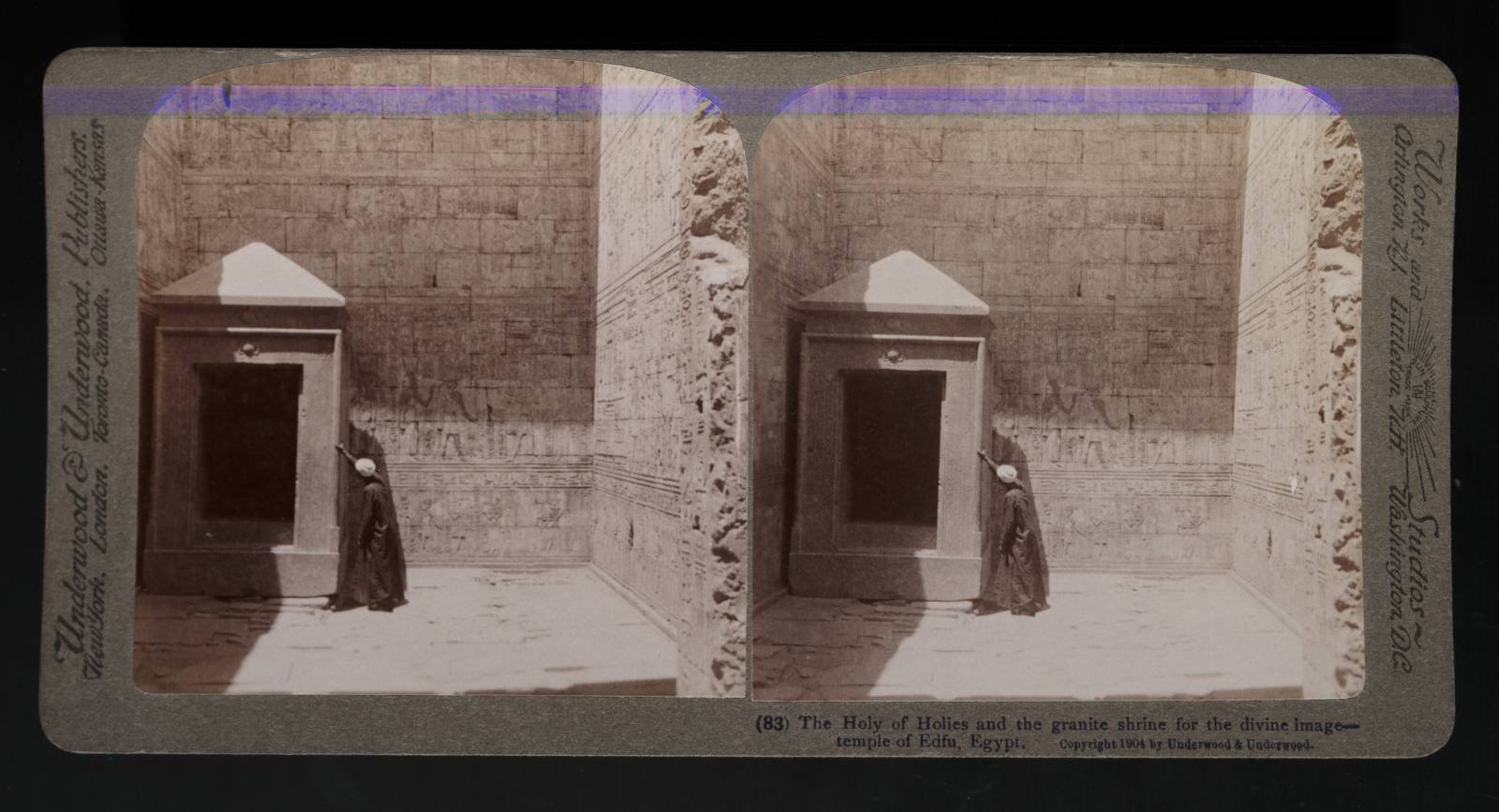Egypt Through The Stereoscope
A Journey Through The Land Of The Pharaohs
by James Henry Breasted | 1908 | 103,705 words
Examines how stereographs were used as a means of virtual travel. Focuses on James Henry Breasted's "Egypt through the Stereoscope" (1905, 1908). Provides context for resources in the Travelers in the Middle East Archive (TIMEA). Part 3 of a 4 part course called "History through the Stereoscope."...
Position 83 - The Holy Of Holies And The Granite Shrine For The Divine Image In The Temple Of Edfu
 This broad band of sunshine falls through the square hole in the roof which we saw but a moment ago from the top of the pylon tower. For we are now standing, as we then said, where only the king and the high priest were allowed to enter, in the Holy of Holies of the great Horus temple of Edfu. What would the priestly custodians, who kept this place inviolate, have said could they have known that our profane feet would one day desecrate this place? Here we may enter, with none to stay us, where the sacred processions stopped, as the High Priest went in to perform the daily ritual before the god in the holy place, while on great feast days, a multitude of this man's ancestors thronged the court outside.
This broad band of sunshine falls through the square hole in the roof which we saw but a moment ago from the top of the pylon tower. For we are now standing, as we then said, where only the king and the high priest were allowed to enter, in the Holy of Holies of the great Horus temple of Edfu. What would the priestly custodians, who kept this place inviolate, have said could they have known that our profane feet would one day desecrate this place? Here we may enter, with none to stay us, where the sacred processions stopped, as the High Priest went in to perform the daily ritual before the god in the holy place, while on great feast days, a multitude of this man's ancestors thronged the court outside.
They were simple villagers like him, but they never saw the interior of this holy chamber. When was the last service performed here? The edict of the Roman emperor Theodosius in 378 A. D., forbade all further worship of the old gods, enjoined the closing of all their temples and at least nominal adherence to Christianity; and this was less than 350 years after the death of Christ.
But although this edict was enforced in Lower Egypt , in the Delta, which we have left over 400 miles down river, it could not at that time be enforced here in Upper Egypt . The service of Horus in this temple may have gone on for a hundred years more, languishing year by year as the temple revenues decreased, until it finally ceased altogether some time in the 5th century after Christ. By that time all the splendid temples we have seen were deserted, converted into Christian churches or filled with the wretched brick hovels of the ragged and filthy poor.
We are standing just outside the door of the chamber, and you see the doorpost of the entrance door on the right (Plan 16). The pavement, so long untrodden by priestly feet, is in places sunken and depressed. The walls are covered with the closely written hieroglyphs of the Ptolemaic age, rude and careless compared with the beautiful writing of the classic 18th Dynasty. The reliefs are only monotonous repetitions of what we saw on the first pylon, that is, the king before one of the gods of the temple, making offering and sacrifice.
On the left is the very shrine in which the sacred image of the god was kept, now open, bare and empty. It is cut out of one block of granite from the first cataract, and you see round the edge of the doorway, the jamb against which the solid bronze door once closed. It is covered with religious inscriptions, and over the door we see the sun-disk, with the sacred serpents hanging down on either side of it.
Such a shrine must have been a splendid object before it was stripped of its adornments.
Ramses III thus describes one which he made for the temple of Karnak:
“I made for thee a mysterious shrine in one block of fine granite; the double doors upon it were of copper in hammered work, engraved with thy divine name. Thy great image rested in it, like the Sun-god in his horizon, established upon this throne unto eternity in thy great and august sanctuary.”
Ramses then goes on to describe the splendor of the ritual vessels used in the service of the god. The most magnificent vessels, were brought before him, wrought of silver and gold, and inlaid with costly stones; while the ornaments, which it was the king's duty to attach to the figure of the god in this shrine, were of the most costly workmanship.
We can form but a very meagre conception of the riches which the chambers around us here on every side, once harbored. But the wealth of these priesthoods has now all vanished, and the once richly filled chambers now stand bare and empty like this shrine. To one who knows what was once here, it is a melancholy experience to stand in this place; but we have still several hundred miles of river to traverse, and we must leave it to the sombre memories that throng so thickly about it.
The next stage of our journey will take us to Assuan On Map 3 you will find Assuan, nearly seventy miles south of Edfu and on the opposite or eastern side of the river. Our Map 17 gives its location and environs in more detail. The lines marked 81 on this map show that we are to stand first on the western river bank and look south.
